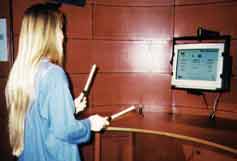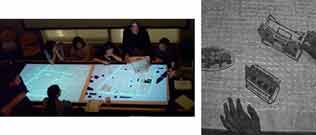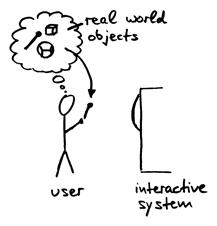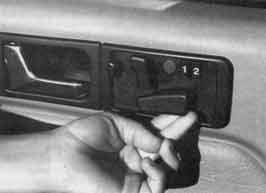| back to index | |||
H11 Domain-Appropriate Devices * |
|||
 A visitor using the WorldBeat exhibit. For a video example of this system in use, see http://www.actibits.com |
|||
|
....you have decided about the application area of your
interactive system, and you are trying to make it attractive and
cooperative - Attraction Space,
Cooperative Experience. Now, you
have to decide how the user should physically interact with your
system.
|
|||
|
* * *
|
|||
| Interactive systems are used in a huge variety of
application domains. Yet, they almost invariably use standard input
and output devices.
|
|||
|
Every interactive software system has a domain in which it is used, or which it addresses, and that its contents or functions are about. The application domain of a computer-based drawing course, for example, is the artistic domain of drawing, and the application domain of a power plant process control system is that power plant with its functions. |
|||
| Many metaphors, few devices |
However, most interactive systems have been using the standard keyboard and mouse as input devices, plus a monitor as output device, but nothing else. User interface designers put a lot of work into creating "metaphors" in which the virtual, on-screen world resembles items and concepts from the well-known, physical world. But all the while, those objects remain virtual, volatile images on a standard screen to be manipulated with the same, generic set of input devices and physical actions: type, point, click.
A claim that is often heard is that incorporating dedicated input
and output devices is too expensive. But often, it is not even
attempted to estimate the amount of extra work and its possible
payoff, because it requires a lot of thinking from the designers
to come up with new ideas apart from mouse and keyboard, and it is
an area where products and standards are not as comfortably
developed and accessible as in the world of standard input
devices.
|
||
| Natural mappings |
But psychological research as well as common sense tell us that users are much more efficient, successful, and satisfied when they are offered I/O devices that resemble physical objects of the application domain. For example, Norman [1988, pp. 23 ff.] talks in detail about the advantages of "natural mappings" from input device to system function, and gives a good example of a device perfectly designed for its dedicated purpose: a car seat adjustment control that is shaped like a miniature seat itself. To adjust his own seat, the user simply pushes the corresponding part of the miniature seat into the desired direction. It would have been far more cumbersome to understand and use the seat controls if they had been designed as a set of industry-standard buttons on the dashboard (and, if we imagine using those controls ourselves, it would probably also have been less fun). |
||
| WorldBeat: batons for music |
The same is true for the WorldBeat system shown in the opening picture: it is an interactive exhibit that demonstrates to its users how computers open up new ways to interact with music, from conducting a computer orchestra, to improvising to a blues band with computer support. While our initial designs included a standard keyboard and mouse as input devices, we gradually found out that we did not really need them, and that they would spoil the "musical atmosphere" that the exhibit tries to create. The two infrared batons, on the other hand, are artefacts that resemble a conductor's baton, or xylophone sticks - objects that are well known from the musical domain. In taking them up, the user is already led away from thinking about interacting with a computer, into an experience of interacting with music. The system was elected one of the three most popular exhibits in the centre where it is installed [Borchers, 1997], and received an award for its new way to convey musical concepts.  Figure: Urp simulates wind between two physical building models [MIT Media Lab, 2000 / Underkoffler and Ishii, 1999]. |
||
| URP: Tangible Bits |
Ishii and Ullmer [1997] developed theconcept of
Tangible Bits, where the gap between human and computer is
bridged by "coupling digital information to everyday physical
objects and environments". For example, they created an
Urban Planning Workbench (Urp)where buildings
are represented by physical models that can be moved around on a
map of the neighbourhood. Effects such as shadows and airflow are
simulated in response to the physical placement of the objects and
projected onto the map. Informal studies showed that most
architects who tried the system would use it immediately if
available [Underkoffler and Ishii, 1999]. This is another example of the
advantages of dedicated, application-specific devices.
|
||
|
Therefore: From the plethora of available input and output devices, choose devices that resemble real objects from the application domain of your interactive system. Whenever users have to input something, or receive information from your system, determine whether the standard periphery is really the best choice for this purpose, or if other devices can make working with the system more intuitive, efficient, and enjoyable. |
|||
 |
|||
|
* * *
|
|||
|
A new device is also a good starting point to create a
system that looks fresh, different, and intriguing - Innovative Appearance, and that does not look like "a
computer" - Invisible Hardware. If your
interactive system requires different forms of input, it may be
feasible to map them to your new input device - One Input Device.
|
|||
This pattern is taken from the book "A Pattern Approach to Interaction Design" (PAID) by Jan Borchers (John Wiley and Sons, Chichester, UK, 2001). Copyright 2001 John Wiley and Sons. Used by permission. See http://media.informatik.rwth-aachen.de/paid.html for more information. Online version by Susan Babutzka, ETH Zurich (subabutz_at_student.ethz.ch). |
|||
